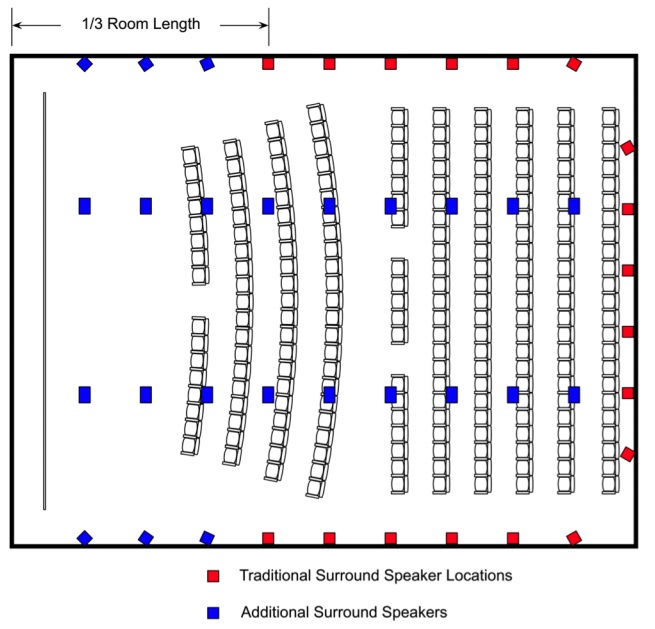Immersive
or 3D Sound Overview
3D sound formats not only include the traditional
5.1 surround sound setup, they also add more channels for 3D sound effects, the
sounds has to be reproduced in all the three dimension according to the picture
in the screen XYZ.
Auro 3D
The Auro-3D system by Belgian developers
Van Baelen includes a total of 11.1 channels. In addition to the original 5.1
channels, Auro adds another 5.0 system on top - as well as a 'Voice of God'
channel embedded in the ceiling.
Theater owners praise the economy and
practicality of Auro-3D® sound systems. Auro-3D®'s unique usage of height
channels (combined with conventional speaker layouts) adds significant value
for filmmakers, cinema owners and audiences worldwide.
In order to reach full market potential,
Auro Technologies has teamed up with Barco as exclusive partner for cinema.
Auro 11.1 by Barco has already been installed in over 50 cinemas worldwide .
Auro 3D: 11.1 channels
Main Layer
|
Upper Layer
|
Left
|
Left
|
Center
|
Center
|
Right
|
Right
|
Surround Left
|
Surround Left
|
Surround Right
|
Surround Right
|
LFE
|
Voice of God (VOG)
|
Dolby Atmos
Dolby®
Atmos™ is a revolutionary new audio platform. It allows for more powerful
storytelling by giving content creators unprecedented control of the placement
and movement of sound within the movie theatre. Combining products, services,
and technologies, Dolby Atmos represents a complete end-to-end audio platform
for movies now and well into the future.
Dolby
Atmos enables a new level of artistic expression for content creators and at
the same time simplifies audio postproduction. With Dolby Atmos, it’s finally
possible to match sound precisely to the action onscreen and to do so easily.
The result: more powerful storytelling.
Dolby
Atmos adds the flexibility of dynamic audio objects to the traditional
channel-based workflows used to create movie soundtracks. These audio objects
allow content creators to control discrete sound elements in the theatre, no
matter the speaker configuration. Objects can be static or can move, and they
are controlled by metadata.
Dolby
Atmos also brings new efficiencies to the audio postproduction process. It
allows sound mixers to efficiently capture the director’s vision and then monitor
or automatically generate 5.1- and 7.1-channel versions in real time.
Distribution
is simplified, too. With Dolby Atmos, all the artistic intent is embedded in a
file within the Digital Cinema Package (DCP), which can then be faithfully
played back in a broad range of theatre configurations.

Atmos allows you address the speakers in both ways.
There is a 9 channel bed (L C R Ls Rs Lsb Rsb and
OHL/OHR) which functions in the same way a channel based system always has...
for the speakers not behind the screen, they can be panned to as an array.
Dolby Atmos has also brought back the Left and Right
Extra channels behind the screen, so in reality you actually have an 11.1
channel based system with Atmos that functions just as traditional 5.1/7.1 did.
AURO
3D
|
DOLBY
ATMOS
|
Offer
the immersive 3D audio experience (due
to usage of 3 layers XYZ)
|
Offer
the most immersive audio experience because
of 64 individual Speakers
|
Deliver
a Channel based solution
|
Deliver
a Object based solution
|
Provides
3 Dimensional Surround (XYZ)
|
Provides
Full Range Immersive Surround
|
Create
an Wide sweet spot
|
Creates
an Enlarged Sweet spot
|
Supply
uncompressed audio (PCM)
|
Supply
uncompressed audio (PCM)
|
Backwards
compatible with 5.1 standard
|
Backwards
compatible with 5.1 standard
|
Compatibility
between ALL AURO Formats
|
Upgradable
to ALL DOLBY Formats
|
Compatibility
across all platforms: Cinema, Home AV systems, Automotive, Headphones
|
Compatibility
across all platforms: Cinema only…
|
Existing
5.1 setup can easily be upgraded to Auro-3D with the minimum number of
speakers & amplifiers
|
Existing
5.1 setup can easily be upgraded to Dolby Atmos with the maximum number of
speakers & amplifiers
|
A
simple install on top of existing 5.1 systems
|
A
typical installation needed with the existing 5.1 or 7.1 system
|
All in all, it was an interesting adventure to
compare Barco Auro 11.1, which retains a channel-based orientation with a
single overhead channel, and Dolby Atmos, which implements an object-oriented
approach pan through array with each speaker—including those overhead—being
addressed individually. In my view, Both Atmos and Auro are the winners, in terms of cost, customization and rendering Auro outruns Atmos, and both the formats are in the developing stage. It's all in the hands of content creators, sound designers and exhibitors to decide which format provides the immersive sound, of course the AUDIENCE too....
SOURCE: